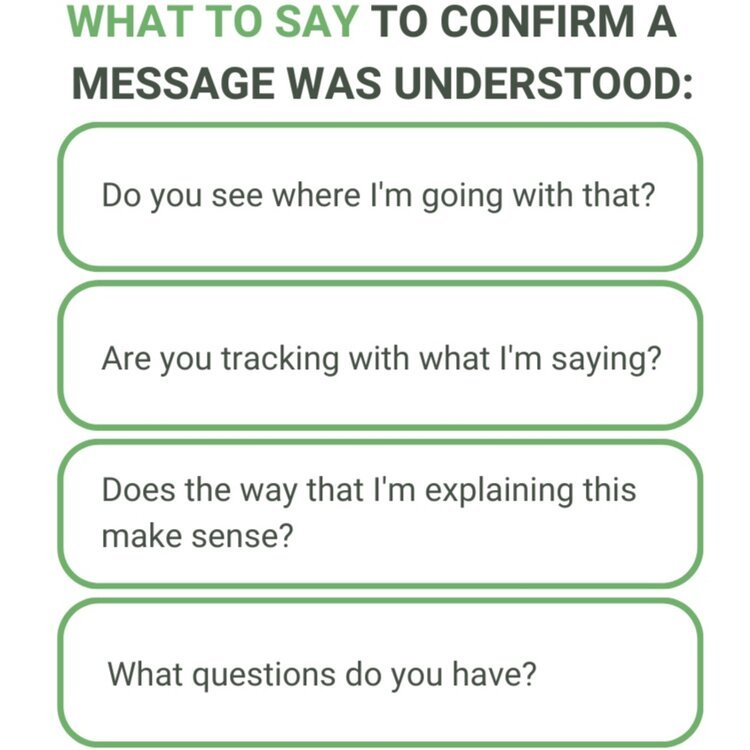The Noise You Cannot Hear
As the sender of the message, it is your responsibility to ensure it has been understood. The first time I remember hearing this idea was in my Project Management certification class at Villanova University. The teacher was very adamant about it, but I was less sure. Doesn’t the receiver have a role to play? Shouldn't people be good listeners and pay better attention? Of course that is true. But of all the elements in the communication cycle, you only have control over yourself. It's in your best interest to take responsibility for confirming that the receiver has understood, and that the message wasn't disrupted by noise.
The communication cycle is one of the foundations of communication knowledge that you may or may not have learned in school, but that impacts you every day in every interaction. The diagram on this page covers the basics. In order for communication to occur there must be both a sender and a receiver. The message is sent using a communication channel. Also present is feedback or lack of feedback and noise… those are the lightning bolts. Often it’s the noise you cannot hear that blocks your message from being received.
"The single biggest problem in communication is the illusion that it has taken place.” - George Bernard Shaw
What is noise?
Noise is anything that disrupts the message between sender and receiver. When people hear the word noise they first think of physical noise. Physical noise is when there is an external noise that is interrupting the message. If I'm presenting on a conference call and someone's dog is barking loudly in the background, that will disrupt my message and receivers will have a hard time receiving it. Physical noise is obvious to both sender and receivers. The fact that the message has been disrupted is known by both parties and another attempt at sending the message can be made once the meeting host mutes the line of the offending party. There are other kinds of noise that disrupt the communication cycle and they are much more dangerous because often times the sender doesn't even realize that the message wasn't received.
Physiological noise is when the receiver is experiencing a biological circumstance that is impacting their ability to receive the message. Imagine you have a toothache and are in need of a root canal. The nerves are sensitive and every breath in is a shock of pain radiating in your jaw. What is the likelihood that you will be able to focus on receiving a message? Pretty low. As the sender, there isn't anything you can do about physiological noise. If you have personal insights about the receiver or can observe a physiological impact it will help you to consider if the message was successfully received.
Semantic noise is when there isn't a shared language between the sender and receiver. As the sender this is the type of noise that you have the most control over because you can adjust your message to reduce semantic noise. Spell out acronyms, avoid jargon, give a one-sentence description to describe things even when you would have thought that the receiver knows what they are. Another thing to watch for is "work-isms". A work-ism is a word or phrase that becomes a popular expression in a professional business setting. Things like "move the needle" and "low hanging fruit". These are only helpful if all receivers have a shared definition for them.
Psychological noise is when the receiver has preconceived biases and assumptions. This type of noise is always present. Humans interpret messages through the lens of our background and experience with the subject and people involved. A successful communicator asks strong questions to both understand more about the other person’s perspective and to open them up to receiving a new message.
Feedback is your only clue into if the message was understood.
That other arrow in the communication cycle, that arrow pointing back to you. It’s the feedback from the receiver and it is the only way to be sure that you've successfully communicated something. Feedback can come in many forms. Body language including facial expression, nodding or shaking head, and crossed arms are all forms of feedback that can help us assess if the message got through. Verbal encouragements like “umm hmm” and “yes” and “I see” help us to know that the message got through.
In our remote meeting culture and when nobody has their camera on, there are times when you get no feedback from the receivers at all. It’s like you’re talking into the abyss. When this happens, don’t let the moment pass and assume your message was received. Remember, it’s your responsibility as the sender to ensure that the message was received. You need to solicit the feedback. Build a list of questions that you can ask to get the feedback you need. Don’t be afraid to ask people by name for their response. You can use tools like chat as a way to get feedback in larger group meetings or when some participants are known to dislike speaking up verbally in meetings.
Conclusion
Some people might call this stuff basic, but I call it foundational. Understanding the communication cycle, recognizing different kinds of noise and how they block your message, and knowing what to do about it are concepts to master so that you can communicate better at work and in life.
If you liked this post and want to be the first to know when new content is available, enter your email address below.


